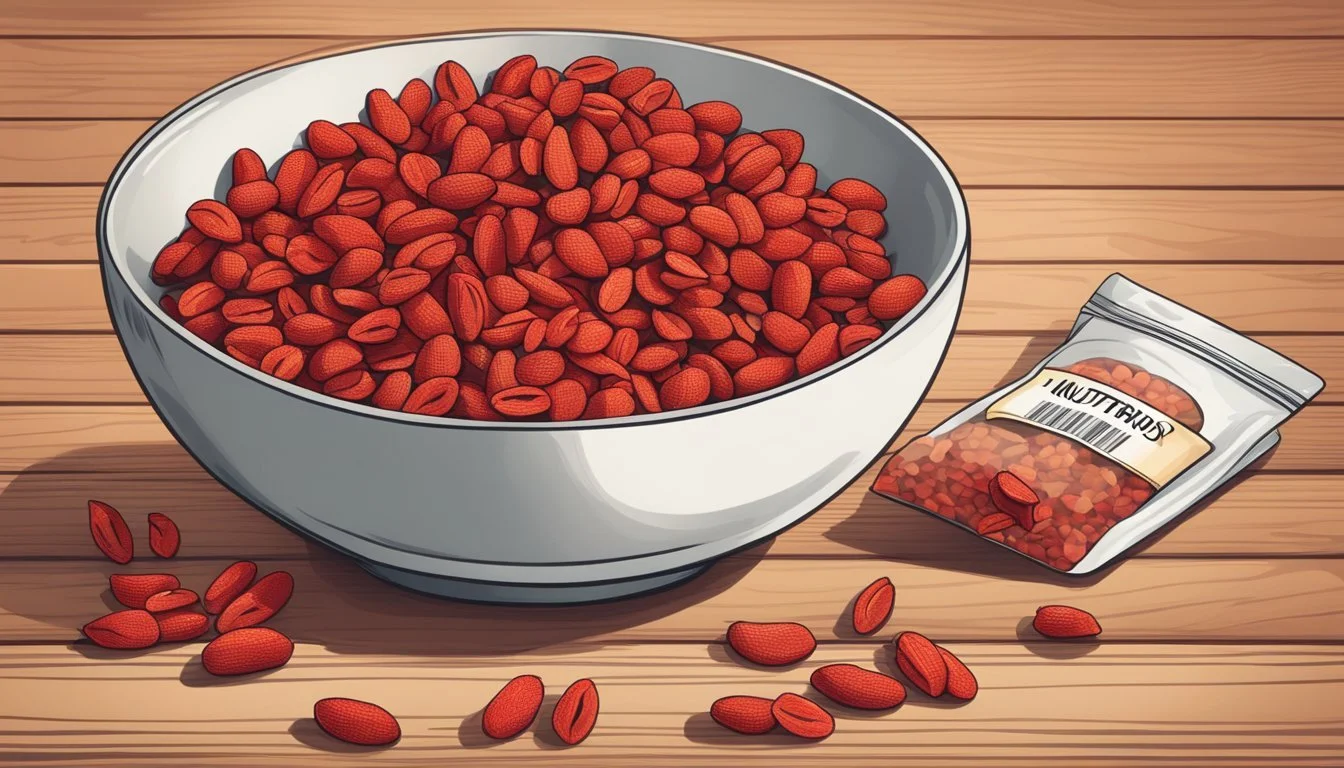How Long Do Dried Goji Berries Last?
Shelf Life and Storage Tips
Dried goji berries are renowned for their longevity and are a staple in many pantries due to their extended shelf life when compared to fresh fruit. Typically, they can last anywhere from four months up to a year. The key to maximizing their shelf life lies in how they are stored. After opening, they should be kept in a sealed jar or an airtight container to preserve their quality and prevent spoilage.
Storing dried goji berries in a cool, dry, and dark place, such as a pantry or a cupboard, further extends their usability. Exposure to heat, light, or moisture can significantly reduce their shelf life and affect their nutritional value. If proper storage conditions are met, goji berries can retain their taste and health benefits for a considerable amount of time, making them a practical and beneficial addition to any diet.
Nutritional Profile of Dried Goji Berries
Dried goji berries offer a dense nutritional profile, rich in vitamins, minerals, and antioxidants. They provide a variety of health benefits and fit well in both traditional and modern diets.
Vitamins and Minerals
Dried goji berries are a potent source of numerous vitamins and minerals. A serving of 28 grams typically contains:
Calories: 98 kcal
Protein: 4 grams
Fat: 0.1 grams
Carbohydrates: Approximately 21.6 grams
Fiber: 3-4 grams
Vitamin A: Essential for eye health and immune function
Vitamin C: Important for skin health and immune support
Iron: Crucial for blood production and oxygen transport
Selenium: Plays a role in metabolism and thyroid function
Potassium: Necessary for muscle function and heart health
Antioxidants and Health Benefits
Goji berries boast high levels of antioxidants, such as:
Zeaxanthin: May reduce the risk of macular degeneration
Polyphenols and phytochemicals: May lower inflammation and reduce cancer risks
These antioxidants contribute to overall well-being, potentially reducing blood pressure and offering protection against various diseases.
Comparison With Fresh Goji Berries
While fresh goji berries contain higher water content and may have a different nutrient balance, dried goji berries retain most of the nutrients and are rich in fiber, making them a convenient healthful snack.
Goji Berries in Traditional and Modern Diets
Goji berries, originating from Asia (specifically from the plants Lycium barbarum and Lycium chinense), have been utilized in traditional Chinese medicine for centuries. They are considered a superfood in modern health food markets, often recommended for their nutrient density and potential weight loss benefits due to their fiber content.
Shelf Life and Storage
When storing dried goji berries, their shelf life is maximized by keeping them in specific conditions that prevent spoilage and maintain their quality.
Optimal Storage Conditions
Dried goji berries should be stored in a cool, dark place such as a pantry to preserve their freshness and quality. The storage area should have low humidity to prevent moisture accumulation. For a longer shelf life, one can also opt to store the berries in the refrigerator or the freezer. In the fridge, dried goji berries can last for up to two weeks, while in the freezer, they may be kept for up to six months. To maintain the berries' quality during storage, one can use vacuum-sealing methods which reduce air exposure and diminish the oxidation process that can degrade the goji berries.
Pantry: 4 months to 1 year
Refrigerator: Up to 2 weeks
Freezer: Up to 6 months
Vacuum-Sealed: Reduced oxidation
Signs of Spoilage
It is important to periodically check the appearance and texture of dried goji berries to determine their quality. Berries that have lost their vibrant color or have changed in texture may be starting to spoil. The presence of mold or an unusual odor are definitive signs that the goji berries have gone bad and should not be consumed. One should also be aware that quality diminishes over time, so the berries may gradually lose their characteristic flavor and nutritional value even if mold is not present.
Appearance: Change in color or size
Texture: Unexpected softness or hardness
Mold: Visible growths or spots
Odor: Unusual or off-putting smells
To preserve their shelf life and quality, dried goji berries require proper storage and regular checks for any signs of spoilage.
Consumption and Serving Suggestions
Dried goji berries offer versatility in their use, suited not only as a nutrient-packed snack but also as a flavorful addition to various meals and drinks. Ideal serving sizes vary, with a common measure being one ounce, which is about two tablespoons.
Integrating into Meals and Beverages
Dried goji berries can be enjoyed raw, lending a chewy texture and a sweet-tart flavor to the culinary palette. In smoothies, a handful can be blended to add fiber and a nutritional boost. For tea enthusiasts, dried goji berries can be steeped in hot water to create a healthful tea. Sprinkling goji berries over cereal or yogurt can enhance breakfast with antioxidants and vitamins.
Recipe Ideas
The application of dried goji berries in recipes is extensive; they can be incorporated into muffins and other baked goods for added sweetness and texture. Trail mix often includes these berries for an extra hint of sourness. They can also be reconstituted in water and used in salsas or sauces to complement savory dishes.
Goji Berries as a Dietary Supplement
As a superfood, goji berries are available in various forms apart from their dried state. Goji berry juice and powder are convenient options for those seeking to harness the benefits in a concentrated form. Additionally, goji berries are sold in tablet form as dietary supplements to support general health.
Health Considerations
When incorporating dried goji berries into your diet, it is important to understand how they can interact with your health. They are packed with nutrition that may help in disease prevention, but they also come with potential side effects and contraindications that should be considered to maintain dietary balance.
Goji Berries and Disease Prevention
Dried goji berries are rich in antioxidants, vitamins, and fiber, which are known to support the immune system and may reduce oxidative stress. Regular consumption of these berries has been associated with health benefits such as a potential reduction in the risk for conditions like diabetes, high blood pressure, and even cancer. They contain compounds that might help in maintaining good eyesight and overall well-being.
Side Effects and Contraindications
Despite their benefits, dried goji berries can cause side effects in some individuals. Reactions may include bloating, diarrhea, and allergies. It is particularly important for those on medication such as warfarin to consult healthcare providers, as goji berries can interact with the drug. Pregnant or breastfeeding women should also seek medical advice before consuming goji berry supplements due to their potency.
Moderation and Dietary Balance
Dried goji berries should be consumed in moderation to avoid adverse effects. A typical serving size is about 5 tablespoons (28 grams) per day. While they can be part of a strategy for weight loss and increased energy due to their nutritional content, they should complement a balanced diet to promote overall health without leading to nutrient excesses or deficiencies.
Cultural and Economic Aspects
Goji berries have a rich cultural heritage in Asia and have become a globally traded commodity. Their cultural significance and economic impact are considerable in both their native regions and internationally.
Goji Berries in Asian Culture
In Asian culture, particularly within China, goji berries have been consumed and revered for over 4,000 years. They are often associated with traditional Chinese medicine where they are believed to enhance longevity and overall health. Tibet has also had a historical association with goji berries, using them in traditional dishes and medicinal practices. They are featured in various cultural events, such as the goji berry festival in Ningxia Province, which celebrates the annual harvest. The berry’s prominence in Asian culture manifests in everyday consumption and is deeply embedded in tradition, where they are commonly found in farmer’s markets and used in everyday cooking.
Global Trade and Availability
Globally, goji berries have transitioned from being a traditional Asian food item to a modern health food staple. Their popularity surged, in part, through Instagram and bloggers who touted their health benefits, transforming them into a trendy superfood. They are now widely available in supermarkets, health food stores, and online platforms, making them accessible to a diverse international audience. This accessibility has contributed to their economic significance as a high-value crop for regions such as Ningxia, where the berries are a major export. Their integration into western health food markets has also spurred new varieties of products found in consumer markets worldwide.
Preservation Techniques
Proper preservation techniques for dried goji berries are critical for maintaining their quality and nutritional value over time.
Drying Process
The initial step in preserving goji berries is the drying process. This can be done using a dehydrator or an oven. The objective is to remove moisture adequately to prevent microbial growth. Berries should be dried until they reach a leathery texture but are not overly hard.
Packaging and Longevity
After dehydration, packaging is key to maintaining freshness. Store dried goji berries in airtight containers or vacuum-seal bags to limit exposure to air and moisture. Stored in a cool, dry place, they have a shelf life of up to 1 year. However, for optimal freshness, keep them in the refrigerator for up to 2 weeks or the freezer for up to 6 months. Ensure to check the expiration date and look out for any signs of spoilage before usage.
Rehydration Methods
To soften dried goji berries for consumption, rehydrate them by soaking in liquid. Briefly submerge the berries in hot water or juice until they are plump and tender. Rehydration not only makes them easier to eat but can also enhance flavor infusion if a flavored liquid is used.







